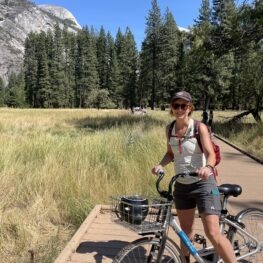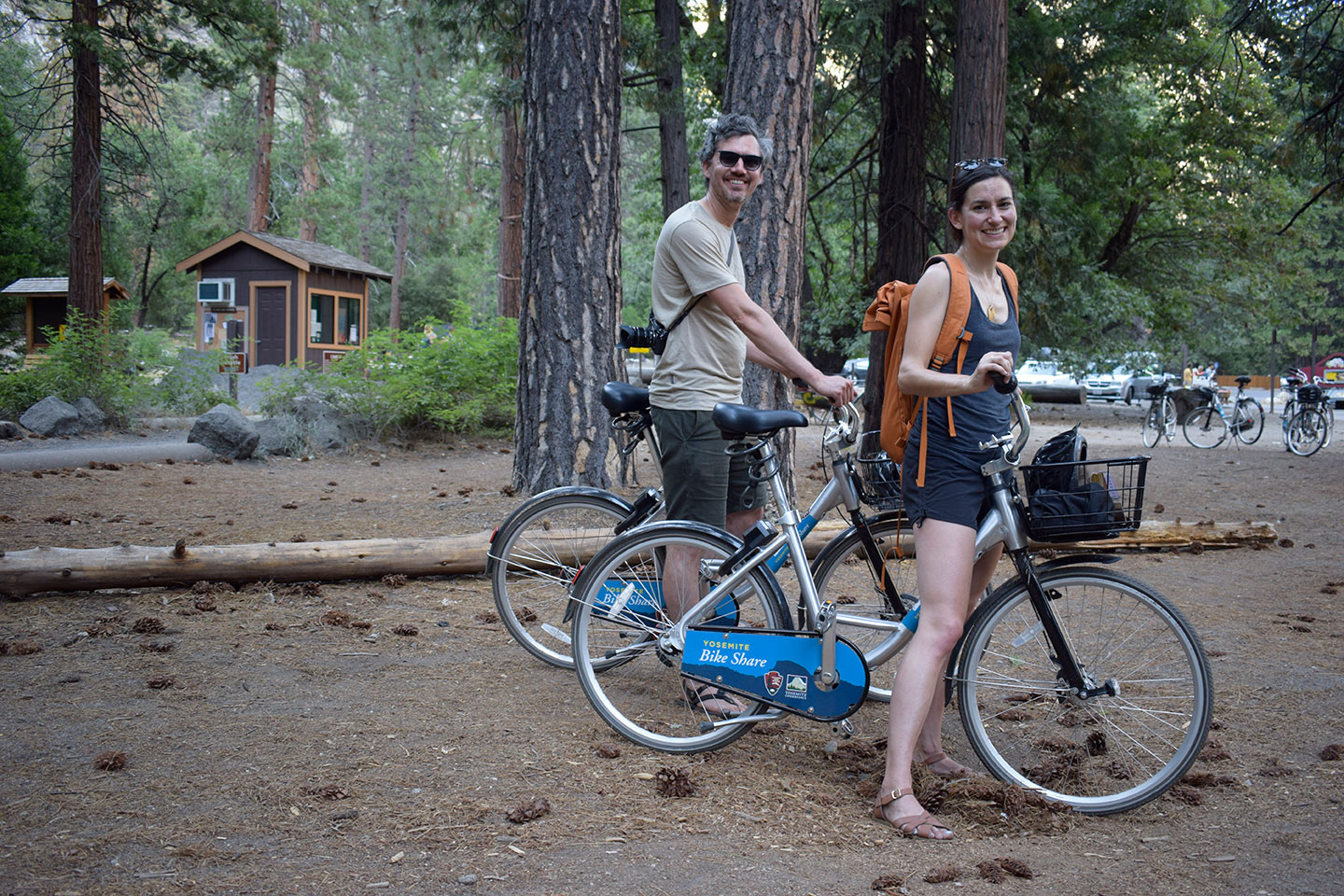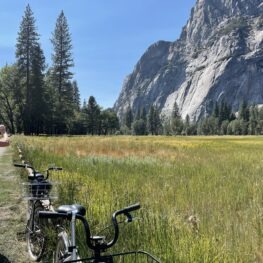
Photo courtesy of Suzanne Wojtasek
This blog includes tips to bike around Yosemite on your next visit! We provide a list of options to consider if you’re interested in bike rentals in the park — including the benefits of using our FREE Bike Share program to travel around the Valley.
Plus, read an *extended edition* of Getting Around, Greener, a story first featured in print in our Autumn/Winter donor magazine.
Last but not least, we offer tips for getting to, from, and around the park without a car.
No matter which option you choose, thank you for choosing to bike or take public transit during your trip to Yosemite — you are supporting sustainability in the park!
Getting Around, Greener — Extended Edition
By Elizabeth Sherer. This project update appears in the Autumn/Winter 2022 edition of the Yosemite Conservancy magazine.
The Yosemite Bike Share program, a much-loved collaboration between the Conservancy and the National Park Service, was introduced in 2018. It was proposed, in part, as a solution to address congestion and improve traffic flow during the park’s busiest months. And it has an additional benefit: the potential to help clear the air of the pollution that accumulates in the often-crowded Valley.
While smoke from wildfires is known to dramatically worsen Yosemite’s air quality, certain areas of the park experience elevated levels of particulate matter and ground-level ozone regardless of fire activity. Some of that pollution is from local vehicle traffic and could be remedied by fewer cars on the roads.
With this in mind, the park purchased a fleet of bicycles, which offer an emission-free way to navigate the Valley. Since the pilot, the Bike Share team — with the help of donors and participant feedback — has made some major improvements to the program. They’ve upgraded the Yosemite Bike Share mobile app; relocated bike pickup and drop-off locations for improved visibility, cell service, and convenience; added custom bike racks; and increased the number of available bikes.
This year, the program is once again made possible thanks to the generosity of Peet’s Coffee, the Yosemite Bike Share’s primary sponsor, which has helped fund the program since its inception. “Our team at Peet’s loves Yosemite,” says Robyn Quintal, the company’s senior director of customer development and operations. “We’ve all sat in traffic in Yosemite, so we were inspired by the idea of an easy, free alternative to getting around the Valley by car. Sustainability has always been a core value for us, going back to the 1960s, when our founder, Alfred Peet, was known for riding his bike everywhere. The Bike Share really resonates with us. We’ve loved watching it grow and expand in the park.”
Other donors, such as Rod Hoadley, have made important contributions to the program. Through his company, Peak Racks, he developed and donated custom-made racks to store the bikes between rides.
“To me, [biking] is the absolute best way to get around Yosemite. Not only is it efficient, but it’s also fun — you see so much more of the park! I want everyone to ride bikes, and I want it to be easy,” says Hoadley.
Biking around Yosemite Valley is a thrilling experience. Somehow the towering granite seems to swallow you up on a humble little bicycle. Or perhaps that’s just the inevitable result of juggling competing priorities — staring up in awe, and staying focused on the road.
The bikes are available for up to two hours per trip and offer an appealing alternative to driving in traffic — and finding a parking space — especially for short trips or quick errands. Did we mention they’re completely free to ride?
With 12 miles of paved paths to explore, you can maximize your short time in the park with a ride along the paved portions of the Valley Loop Trail. Stop by must-see destinations like Mirror Lake, or scope out an off-the-beaten-path picnic spot along the Merced River.
But the overall cycling experience in Yosemite can still be improved, particularly on the west side of the Valley, where cyclists must brave busy roadways, dodging pedestrians, cars, and buses. Ironically, this can be more challenging on a day with very little traffic, when vehicles speed by at 35 miles per hour and cyclists hug the narrow shoulder as they pedal past Valley View.
Acknowledging this current challenge — and opportunity — the National Park Service is taking preliminary steps to plan for a bike-friendly future. With support from Conservancy donors, the park has embarked on a 2022 bike transportation study, with the goal of considering possible improvements to bike and pedestrian infrastructure in high-traffic areas.
The advantages of a bike-friendly Yosemite are not limited to humans. There are ecological benefits, too. In the long term, this project has the potential to protect Valley habitat from trampling. By expanding or connecting trails or paved pathways — and designing infrastructure that is better suited to both pedestrians and cyclists — visitors will be less inclined to ride or walk across sensitive vegetation.
Thanks to donor support, the park and the Conservancy are working to recognize cycling — an environmentally friendly, safe, and growing mode of transportation — as an integral part of addressing the air pollution and traffic congestion, creating space for even more visitors to successfully cycle around busy Yosemite Valley.
Acknowledging this current challenge — and opportunity — the National Park Service is taking preliminary steps to plan for a bike-friendly future. With support from Conservancy donors, the park has embarked on a 2022 bike transportation study, with the goal of considering possible improvements to bike and pedestrian infrastructure in high-traffic areas.
The advantages of a bike-friendly Yosemite are not limited to humans. There are ecological benefits, too. In the long term, this project has the potential to protect Valley habitat from trampling. By expanding or connecting trails or paved pathways — and designing infrastructure that is better suited to both pedestrians and cyclists — visitors will be less inclined to ride or walk across sensitive vegetation.
Thanks to donor support, the park and the Conservancy are working to recognize cycling — an environmentally friendly, safe, and growing mode of transportation — as an integral part of addressing air pollution and traffic congestion, creating space for even more visitors to successfully cycle around busy Yosemite Valley.

Yosemite Bike Share and Bike Rentals
WHO:
The National Park Service partners with Yosemite Conservancy to offer the free Yosemite Bike Share — a bike borrowing program for park visitors. This collaboration is made possible through the generosity of Peet’s Coffee and other donors. Yosemite Hospitality, the park’s concessionaire, also offers bike rentals.
WHAT:
Yosemite Valley offers 12 miles of paved pathways for cyclists. Bicyclists can also ride on regular roads throughout the park, but are expected to obey traffic laws. The speed limit for all bikers is 15 mph. You can rent a bike, bring your own, or borrow one through the Bike Share program.
WHEN:
Through the Bike Share program, which operates seasonally, free bikes are usually available between May and October. Bike rentals are also available seasonally, usually in spring, summer, and fall. Rental kiosk hours may vary based on weather.
WHERE:
You’ll find Bike Share stations in two locations: at the Yosemite Village day-use parking area (sometimes called Camp 6) and the Yosemite Valley Lodge day-use parking lot. Bike rentals are offered at Curry Village, Yosemite Village, and Yosemite Valley Lodge. This map of Yosemite Valley highlights paved pathways designated for cyclists and pedestrians.
WHY:
The Yosemite Bike Share program was initially proposed to help address traffic congestion in the Valley during the park’s busiest months. Cycling has many benefits for Yosemite, from reducing air pollution to habitat preservation — read more below, in Getting Around, Greener, a project update featured in the Fall/Winter 2022 edition of the Yosemite Conservancy magazine.
HOW:
For the best Bike Share experience, we strongly recommend downloading the free Yosemite Bike Share app for Apple/iOS (via the App Store) or Android (via Google Play) before you arrive in the park. From there, follow these steps:
- Sign up using your mobile number and email address. Once you register, you’ll receive a pin via text. When prompted, enter the pin in the app.
- Head to a Yosemite Bike Share station to pick up a bike.
- Choose a bike. Before you pick up a bike, make sure your Bluetooth and location services are enabled on your phone! Use the app to unlock the bike’s rear wheel by scanning the QR code between the handlebars. When you scan the code, the lock on the bike’s rear wheel automatically opens.
- Stay safe: Use the helmet provided with the bike, or bring your own. To unlock the helmet, click the symbol on the app.
- Pedal to your destination. Stick to roads and designated bike paths (see map below). You can keep a bike for up to two hours at a time.
- When you’re done riding, return the bike to the station where you picked it up. Be sure to leave the bike in the “Used Bike Corral” area. To end your ride and lock the bike, manually close the lock on the rear wheel and press STOP on the app. Double-check that the app has registered the end of the ride before you leave!
Other Tips for Navigating Yosemite Car-Free

Photo courtesy of Suzanne Wojtasek
For those with accessibility challenges that preclude cycling, or anyone with limited experience biking on busy roads, there are alternative transit options that can help you navigate to and within the park in a more sustainable way.
With the free Yosemite Valley shuttle system; the Tuolumne Meadows hikers bus operated by Yosemite Hospitality; and the fee-based Yosemite Area Regional Transportation System (a Merced-based public transit service known
locally as YARTS), which services Wawona/Mariposa Grove, Crane Flat, Hodgdon Meadow, and elsewhere; you can access most of the park’s must-see destinations via public transportation in the high season. Learn more on NPS.gov/yose: Public Transportation.
If you’re traveling from the San Francisco Bay Area or Los Angeles, you can take an Amtrak train to Fresno or Merced, then transfer to a YARTS bus to get to Yosemite Valley. While it’s a bigger time commitment than driving a personal vehicle, it’s a relatively low-cost option.
Header and thumbnail image courtesy of Kristin Silver.
